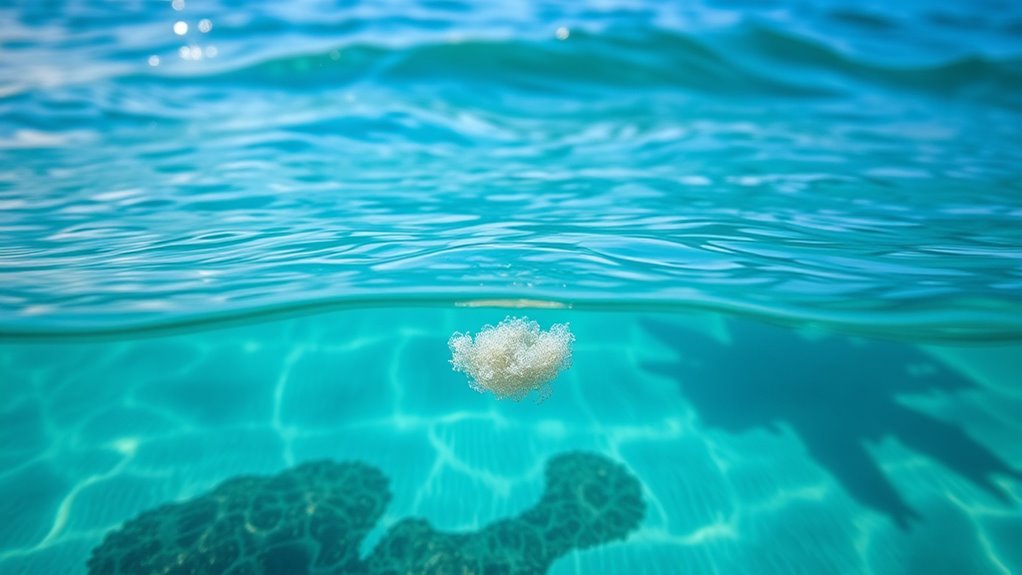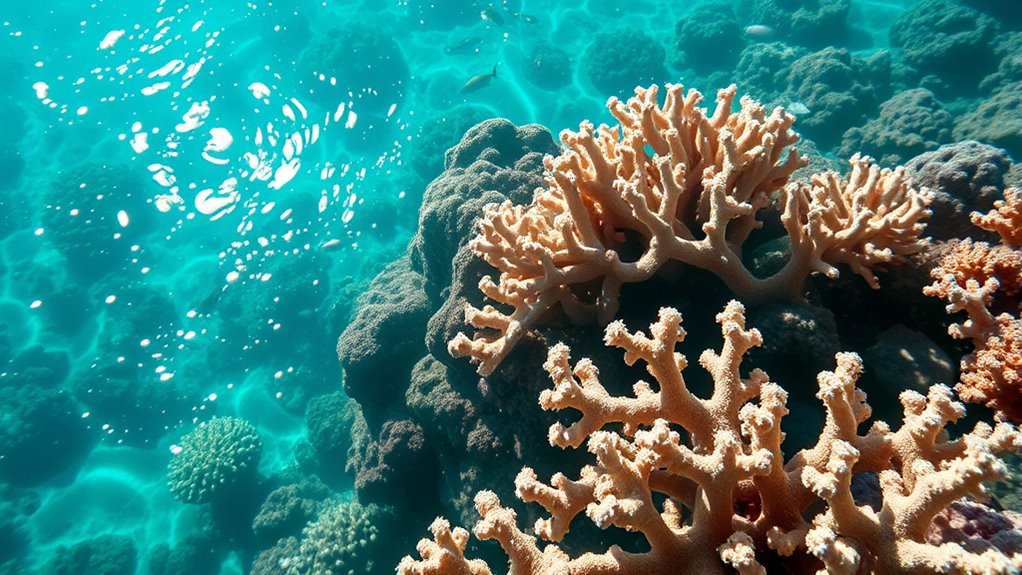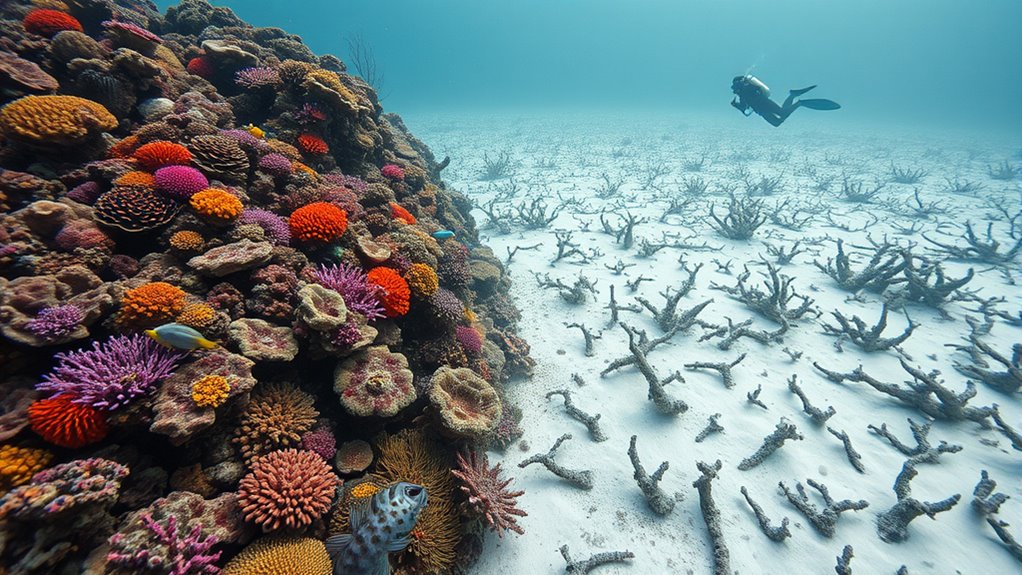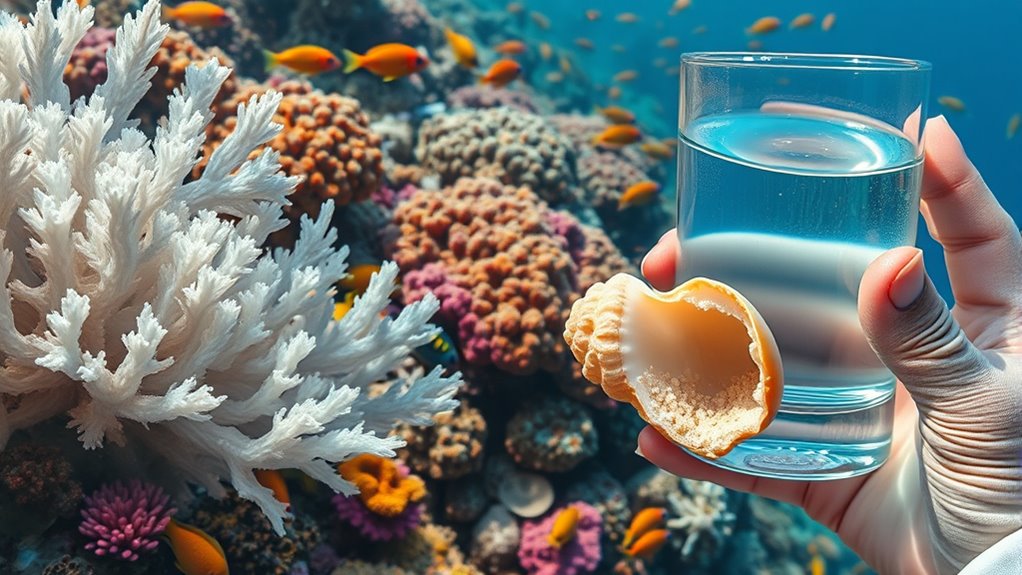Ocean acidification happens mainly because human activities release lots of CO₂, which dissolves in seawater. This chemical reaction forms carbonic acid, lowering the ocean’s pH and making it more acidic. As a result, marine life like corals and shellfish struggle to build their shells and skeletons, harming ecosystems and fisheries. To understand how these changes affect the ocean and what you can do about it, keep exploring the detailed visual explanations ahead.
Key Takeaways
- Visualize how increased CO₂ emissions from human activities lower ocean pH through chemical reactions forming carbonic acid.
- Illustrate the process of CO₂ dissolving in seawater and disrupting carbonate chemistry crucial for marine life.
- Show the impact of ocean acidification on coral reefs, including bleaching and weakened shells.
- Depict broader ecological effects, such as declines in biodiversity and disruptions to food webs affecting human livelihoods.
- Highlight mitigation strategies like renewable energy, policy reforms, and conservation efforts to combat ocean acidification.
What Causes Ocean Acidification?

Ocean acidification occurs primarily because of increased carbon dioxide (CO₂) emissions from human activities. When you burn fossil fuels, CO₂ is released into the atmosphere and absorbed by seawater. This triggers chemical reactions that alter the ocean’s chemistry, leading to pH level changes. As CO₂ dissolves in seawater, it forms carbonic acid, which lowers the ocean’s pH. These chemical reactions reduce the availability of carbonate ions that marine organisms rely on to build shells and skeletons. The more CO₂ you emit, the more pronounced these pH level changes become, making the ocean more acidic. High contrast ratios can help observers better discern subtle differences in color and detail, which is essential for understanding complex chemical changes in marine environments. This shift in acidity disrupts marine ecosystems and threatens many species that depend on stable chemical conditions for survival.
How Carbon Dioxide Affects Seawater Chemistry

When carbon dioxide (CO₂) dissolves into seawater, it triggers a series of chemical reactions that considerably change the ocean’s chemistry. CO₂ reacts with water, forming carbonic acid, which disrupts the carbonate chemistry balance. This process causes pH fluctuations, making seawater more acidic. As carbonic acid forms, it releases hydrogen ions, lowering the pH and reducing carbonate ions needed by marine organisms to build shells and skeletons. These changes in seawater chemistry have a direct impact on the ocean’s ability to maintain stable conditions. The more CO₂ dissolves, the more pronounced these chemical shifts become, leading to a less hospitable environment for many marine species. Additionally, understanding the effect of ocean acidification on marine ecosystems underscores the urgency of reducing carbon emissions. Understanding this process highlights the importance of controlling CO₂ emissions to protect ocean health.
Impact on Marine Organisms and Coral Reefs

As carbon dioxide dissolves into seawater and shifts its chemistry, marine organisms that rely on calcium carbonate to build their shells and skeletons face increasing challenges. Higher acidity makes it harder for corals and shell-forming creatures to maintain their structures, leading to shell dissolution and weakened skeletons. Coral reefs become more vulnerable, experiencing frequent coral bleaching events that disrupt ecosystems and threaten marine biodiversity. Shell dissolution accelerates as the water’s pH drops, causing shells to weaken and break apart more easily. This not only impacts individual species but also the entire food web. You might notice less vibrant reefs and fewer shellfish, signaling the broader effects of ocean acidification on marine life. The damage is ongoing, and without intervention, these essential ecosystems face serious decline. Understanding ocean chemistry is crucial for developing effective conservation strategies.
The Broader Ecological and Human Consequences

The ecological and human consequences of ocean acidification extend far beyond the immediate impact on marine life. As marine biodiversity declines, entire ecosystems become destabilized, affecting species that rely on healthy reefs and ocean habitats. This loss disrupts food webs, threatening the survival of fish populations that many communities depend on for food and livelihood. Fisheries sustainability suffers as fish stocks decrease and become harder to catch, leading to economic hardships for fishing communities. Additionally, fewer marine organisms mean less biodiversity, which weakens the ocean’s resilience to environmental changes. The ripple effects threaten global food security and coastal economies. Addressing ocean acidification is essential to preserve marine ecosystems and guarantee the continued well-being of human societies that rely on the ocean’s resources.
Ways to Mitigate and Address Ocean Acidification

Addressing ocean acidification requires proactive strategies to reduce carbon emissions and protect marine environments. You can support the shift to renewable energy sources like wind, solar, and hydro power, which lower greenhouse gases that cause acidification. Implementing policy reforms is essential; governments can set stricter emission standards, incentivize clean energy investments, and fund marine conservation projects. Public awareness campaigns encourage responsible consumption and support for sustainable practices. Restoring coastal habitats such as mangroves and seagrasses helps absorb CO2 and buffers ocean chemistry. International cooperation is critical to enforce global emission reductions. Additionally, fostering creative practice within scientific research and environmental advocacy can inspire innovative solutions for combating ocean acidification. By combining these efforts—advancing renewable energy, reforming policies, and promoting conservation—you play a fundamental role in mitigating ocean acidification and safeguarding marine ecosystems for future generations.
Frequently Asked Questions
How Do Scientists Measure Ocean Acidity Levels Over Time?
You can measure ocean acidity levels over time through pH monitoring and chemical analysis. Scientists use pH sensors to record real-time data, tracking changes in acidity. They also collect water samples for chemical analysis in labs, which helps determine the concentration of dissolved carbon dioxide and other chemicals affecting pH. This combination of methods allows scientists to monitor long-term trends in ocean acidity accurately.
What Regions Are Most Vulnerable to Ocean Acidification?
Think of ocean regions like fragile glass; some areas are more vulnerable to acidification. Coastal zones with high CO2 absorption, such as the Arctic and parts of the Pacific, face the greatest risks. You’ll see coral bleaching increase and fisheries decline more sharply there, threatening marine biodiversity and local economies. These vulnerable regions need urgent attention to protect ecosystems and sustain livelihoods affected by changing ocean chemistry.
Can Ocean Acidification Reverse Naturally or With Intervention?
You might wonder if ocean acidification can reverse naturally or with intervention strategies. While natural recovery is limited because CO2 levels remain high, certain interventions, like reducing emissions and restoring marine ecosystems, can help slow or halt acidification. However, reversing it entirely is challenging and requires global efforts. Your best hope lies in proactive intervention strategies combined with addressing climate change to protect ocean health.
How Does Ocean Acidification Affect the Food Chain?
You might not realize it, but ocean acidification impacts the entire food chain. As it causes coral bleaching and shell deformation, many marine species lose their habitats and protection. This disrupts predator-prey relationships and reduces food sources for fish and other marine animals. When these foundational species decline, it creates a ripple effect, affecting larger predators and ultimately threatening the health of the whole ocean ecosystem.
What Role Do Governments Play in Addressing This Issue?
You see, governments play a vital role in addressing ocean acidification through policy responses and fostering international cooperation. They can implement regulations to reduce CO2 emissions, invest in research, and promote sustainable practices. By working together globally, they create stronger policies and share resources to combat acidification effectively. Your government’s commitment can drive meaningful change, protecting marine ecosystems and ensuring a healthier future for everyone.
Conclusion
As you imagine the ocean’s surface shimmering, think of how rising CO₂ levels quietly seep in, transforming its chemistry like a hidden tide. This coincidence of human activity and natural systems means your choices can protect vibrant coral reefs and diverse marine life. By reducing emissions and supporting sustainable practices, you become part of the wave that can restore balance. Together, you can turn this visual of crisis into a future of hope beneath the waves.










